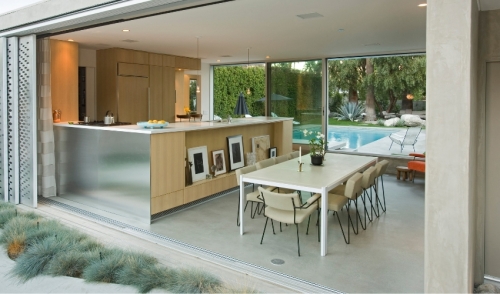
Designing Outdoor Kitchens
The grill is the main ingredient, but there's a lot more to a successful recipe.
Today’s outdoor kitchen designs—whether part of a new home or a remodel—are more likely than ever to complement a home’s architectural aesthetic and environment. To create inviting and functional living spaces, where all the features work together, you need a refined and thoughtful approach. Here are a few design concepts to help you make that happen.
Start With the Grill
The heart of any outdoor kitchen, big or small, is the grill. It can make or break a client’s satisfaction with a project, so select the best one that fits within the budget. When it comes to grills, there are no uniform depths, heights, or widths. This means that upgrading a grill sometime in the future could present a challenge, so its selection should be based on the cooks your clients aspire to be, rather than on the cooks they are now. Also keep in mind outdoor cooking options other than the standard gas grill, such as pizza ovens, smokers, cooktops, and charcoal- or wood-fired grills.
Once the grill has been selected, the next big decision is placement. If your clients entertain often, position the grill so it is perpendicular to the dining area to keep the cook in the party. That way, the cook can work without having his or her back turned to the guests and without having the open hood in the way.
In the Zone
The perfect outdoor kitchen for entertaining is about more than just the appliances. Like indoor kitchens, outdoor kitchens are made up of functional zones. These include hot, cold, wet, and dry zones.
Hot zones, not surprisingly, consist of all cooking areas, like grills, pizza ovens, and cooktops; cold zones include refrigeration and freezers; wet zones include sinks and adjacent workspace; and dry zones are dry prep counters and storage. The key to designing an outdoor kitchen that functions well is planning for all four zones to work together, along with providing plenty of countertop space to support the “workflows” of prepping, cooking, serving, and cleaning. For example, the cold zone should be next to the wet zone, to facilitate moving food from the refrigerator to the sink to wash it and get it ready for grilling in the hot zone.
Think about other outdoor living activities, as well. If there is a pool, consider placing beverage refrigeration near it.
Defining Size
Outdoor kitchens come in all sizes. When you’re determining design, layout, and available space for your clients, it’s helpful to think in terms of four basic categories.
- Small (10 linear feet). A small kitchen generally includes a grill, a cooktop, a sink, and storage. It needs at least 36 inches of usable countertop frontage, no less than 24 inches deep.
- Essentials (13 linear feet). A bit larger, this size typically has a refrigerator in addition to a grill, a cooktop, a sink, and storage. It should have at least 48 inches of countertop frontage, at least 24 inches deep.
- Medium (16 linear feet). To the essentials kitchen, a medium kitchen adds more storage and counter space and sometimes more refrigeration. There should be at least 72 inches of countertop frontage, 24 inches deep.
- Large (more than 20 linear feet). A large kitchen has all the amenities and can accommodate multiple cooks. Provide 156 inches of countertop frontage at 24 inches deep.
Space to Land
You can almost never have too much countertop space. Outdoor kitchens are typically smaller than their indoor counterparts, and insufficient countertop space is one of the most common design shortcomings I see.
Ideally, you should provide your clients with free and clear “landing areas” on both sides of grills, sinks, and cooktops. This space can be used for ingredients, cutting boards, platters, colanders, and other items that the cook needs to have close at hand while using the station. When it’s time to pull the swordfish steaks off the grill, for instance, there needs to be space next to the grill where a platter can be ready and waiting.
Omitting landing areas on one side or both sides of key equipment such as the grill or the sink is the most common design mistake. Similarly, grills and sinks should never be placed at the end of a counter run; there should always be landing areas to the left and right sides of both.
To figure out how much space you should provide for your clients, you can use the following recommendations of basic landing-area dimensions for common outdoor kitchen workstations:
- Grills. Be sure to keep 24 inches of open counter on one side and 12 inches on the other side.
- Cooktops. Maintain 12 inches of open counter on each side. However, when you combine a grill and a cooktop into one station by positioning them next to each other, use the landing area recommendations for a grill (24 inches on one side and 12 inches on the other).
- Sinks require 18 inches of open counter on each side, because your clients will be doing a lot of washing and cleaning in that area.
- Pizza ovens. Landing areas are especially important for pizza prep work. Provide 24 inches of open counter on one side and 12 inches on the other side.
- Kegs. Having room to place and set aside glasses is important for the keg tapper, so provide 12 inches of open counter on each side.
- Under-counter refrigerator/ice maker. Be sure to have 15 inches of open counter above it.
When multiple workstations are combined, the minimum landing area between two pieces of equipment may be determined by adding 50% to the largest landing-area width recommended for the two pieces of equipment. For example, the landing area between a grill and a sink should be at least 36 inches wide because the largest recommended landing area related to those two pieces of equipment is 24 inches next to the grill.
Storage
Many homeowners want fully functioning outdoor kitchens. That includes having places to keep pots and pans, as well as dishes and plates, during the season. Other items, like wood chips, hot mitts, charcoal, and grill brushes, normally remain outdoors at all times, and need permanent storage there.
Because it’s outside, cabinetry needs to be able to withstand the elements. Whatever you select should be able to keep the items inside dry when it rains. I recommend weathertight cabinetry with seamless rain gutters around the door and drawer openings to help divert water.
The recommended amount of linear storage frontage varies depending on the size of the kitchen. The following suggestions assume that smaller kitchens will need to store fewer items outdoors, while larger kitchens are more likely to store pots, pans, and serving pieces:
- Small outdoor kitchen: 21 inches
- Essentials outdoor kitchen: 36 inches
- Medium outdoor kitchen: 72 inches
- Large outdoor kitchen: 96 inches
Seating
There are three main types of seating to think about: dining, bar, and lounge. Having all three is ideal for entertaining. When laying out a space, always try to keep the cook nearby; make sure the primary cooking areas are not isolated from the seating areas.
When planning for seating in an outdoor kitchen, you need to allow adequate width for each seat, as well as space for knees below the table, counter, or bar, and adequate space for traffic behind the seats. Typically, you should allow 24 inches width for each seat, but for more accessible seating, allow 30 to 36 inches.
If there won’t be any traffic behind the seats, you need only 32 inches between the table, counter, or bar and the nearest obstruction. To allow people to just edge past behind the seats, provide 36 inches. If you want guests to be able to walk past unobstructed, make sure you leave at least 48 inches.
For counter and bar seating, also provide space for knees. Here are recommended measurements:
- Lowered-counter/table-height seating (30 inches high) needs 18 inches for knee space.
- Counter seating (36 inches high) needs 15 inches for knee space.
- Raised-counter/bar-height seating (42 inches high) needs 12 inches for knee space.
- Accessible seating (30 to 34 inches high) needs 19 inches for knee space


















